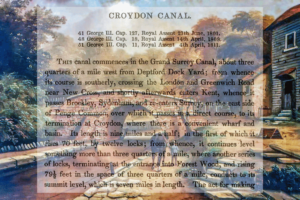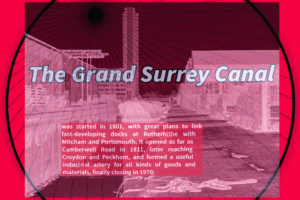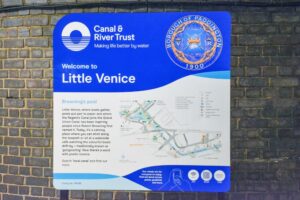Paddington and its transport systems – 1
The building of the Grand Junction Canal between Braunston and Brentford brought the canal network to the River Thames, which in turn ran through the heart of London, giving direct access to the city’s wharves and industry. While this was initially an acceptable state of affairs, there was a desire for a direct waterway link into the capital. People had been making plans long before the Grand Junction was ever thought of, and there were several abortive schemes, some postulated over a century before the canal era began. The most notable of these pre canal-era projects was one from Rickmansworth via Harrow-on-Hill, to a terminus at what is now Centre Point, off Oxford Street. It was a clearly more sophisticated route than the later one via Uxbridge and Bulls Bridge. Uxbridge wasn’t in a hurry to have a navigable waterway for there is some evidence that around 600 years ago the Colne was navigable from the Thames as far as a wharf in Uxbridge. But eventually it found itself on a major water route between London and Birmingham
Paedingas
Well to the east of Uxbridge was the village of Paddington. The name is thought to have originated from the race of the Paed (a Saxon peoples), and it was originally known as Paedingas. Before the canal came it was a small village “situated in the hundred of Ossulton, scarcely a mile north of Tyburn turnpike…” In Saxon times it was known as Osulvestane. The peoples of Paedingas must have originally been forest dwellers as the area was part of the enormous forest of Middlesex. In 1218 it was “disafforested by Henry the Third.” That was one of the first major changes for the people of Paddington. Perhaps the biggest, and the longest, most enduring changes, are those that began with the coming of the Grand Junction canal. Many people were against the new canal including the Bishop of London who spent considerable time campaigning against the new waterway. Incidentally the name Ossulton still lives on in one of the streets sited near Euston station.
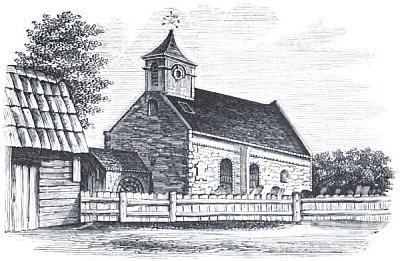
One of the early views of Paddington. The church at Paddington Green before 1791. A new one was built in the 1790’s.
The new church at Paddington Green would have had the Regents Canal passing it if the original plans for a route closer to the Marylebone Road had been built. The new church became a focal point of the struggles against the new canal to Paddington, then later became the church for the Grand Junction Canal Company’s employees since it was very near the new canal basin. The opening of the basin in 1801 brought prosperity to this part of the world, which we must remember was still merely a village just outside London.
The New Canal
The act for the present Paddington Arm was passed in 1795. The works on the main canal between Brentford and Braunston had already begun under an earlier act of 1793 – “An Act for making a Navigable Cut from the Grand Junction Canal, in the precinct of Norwood, in the county of Middlesex, to Paddington, in the said county.” Its engineer was Wiliam Jessop and the chairman was William Praed, whose name lives on in the street of the same name at Paddington.
The section northwards from Brentford to Uxbridge opened in 1794, further reaching Rickmansworth in 1797. Thereon after the works for the Paddngton Arm were begun starting from Bulls Bridge (aka Norwood) and heading towards London. This was a lock-free canal of 13 and half miles, with plans for the country’s first ever pleasure marina (though in those days they didnt have words like marina.) This basin for pleasure boats was soon dropped in place of a much grander commercially oriented basin at Paddington. At the time the new canal was billed as a ‘great liquid road’ – its average width according to Baron Dupin was 59ft. The Grand Junction Canal Company held a opening dinner to celebrate the opening of the 13 mile Paddington Canal from Bulls bridge on the evening of 10th July 1801. News reports of the day claim that at least 20,000 people attended the opening ceremony at Paddington, people were lining the new canal for several miles
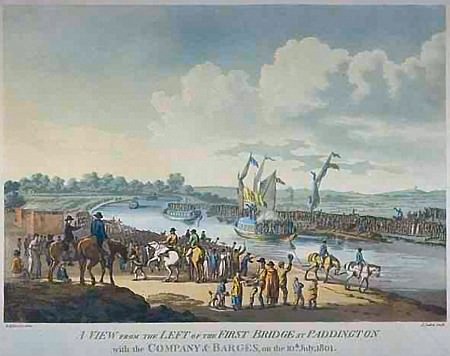

Above: The official opening in 1801. Right: News of the opening. Click on image for larger version.
The Canal opens
The above view depicts the opening ceremony of 10th July 1801. Today this would be a view looking from a spot by Beauchamp Lodge past the Floating Boater and straight down the Little Venice visitor moorings. Westbourne Terrace bridge was not built until much later when the area was developed. Its an interesting perspective because there is no Toll House. The Toll House was built possibly about 1812. The canal company must have collected its tolls at Paddington Basin or Bulls Bridge. The location is now what is Brownings Pool. This stretch of wide water did not come into existence until the Regents Canal was built. The stupendous Kilburn embankment is clearly shown in the image.
According to the Penny Magazine the canal had just ‘one lock.’ It was clearly a stop lock at Bulls Bridge for the one at the Harrow Road bridge (Paddington end) was not built until at least 1802 or early 1803. There was at least one major embankment and aqueduct at the London end. The embankment is clearly visible in the opening ceremony picture shown above. It still exists and parts of it can be found if one looks carefully for it at Little Venice. The aqueduct however disappeared when the Kilburn Stream was culverted, although this stream’s valley can still be seen to the north of the Little Venice moorings. The other major feature was of course the Paddington basin.
The basin at Paddington became a centre of important commerce for 160 years. Its larger four acre basin was added in 1805 and that basin’s dimensions in 1825 were claimed to be 400 yards in length and 290 yards in breadth according to Baron Dupin in his book The Commercial Power of Great Britiain. One wonders if the basin was really 290 yards wide? I think it was an error and should have read 290 feet in width. If it had been 290 yards wide then it was a massive stretch of water wider than the Thames! Even at the lesser 290 feet width as it must have been, it was still clearly a giant compared to that weakling minnow of a basin found in today’s nightmare known as ‘Merchant Square!’
The coming of the railway to the area meant a revival in the basin’s fortunes as it now formed an important interchange facility between canal and railway. The first station was at Bishops Bridge, on what now stands the Sheldon Square (Paddington Central) development. Bishops Bridge remained in service as a goods station until the 1980’s. The main terminus, Brunel’s magnificent station, was not opened until 1854. In 1863, the world’s first underground railway, the Metropolitan Line, commenced at platforms adjacent to the basin on its four mile journey to what was then known as Farringdon and Holborn station.
The decline in commercial canal traffic led to a lengthy debate on the future of Paddington Basin. Some thought it should be filled in whilst others had the view that it was a valuable water space amenity for London. Many years in ‘limbo’ ensued and as the basin entered its 200th anniversary, it had gained a new, if somewhat rather un-canal related future. The increase in boating pleasure activity has ensured that at least there is ample moorings in the basin area for visitors. This is not a new feature actually, it is what Paddington Basin was originally meant to be! What essentially happened is that the original objective for pleasure provision was modified and the idea eventually adapted to form the attractive pool that constitutes the hub of Little Venice.
The Paddington Packet Express Passenger Boat service
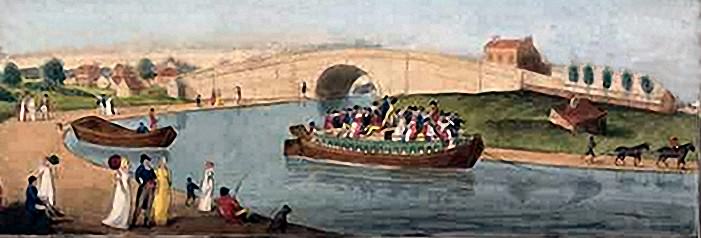
The canal before Brownings Pool was built. The express passenger boat has just departed Paddington Basin and passed the Harrow Road bridge.
This was a out and return service between Cowley and Paddington. Two outwards and return trips were provided on Sundays. Oddly there were no trips on Fridays. In 1816 the first boats began sailing down the Regents Canal and there is some evidence the Paddington Packet boats experimentally travelled as far as Camden Town, but it was not successful due to the tight constraints of the Maida Hill tunnel. This underground canal passageway ran under the hill of the same name and this was the highest point in Paddington at 120ft.
The Paddington Packet express boat service briefly formed part of a passenger transport link between Uxbridge and the City via Hayes and Norwood in 1829-30 by means of a connection with the country’s first omnibus service. The only downside was that the Paddington Packet was nearly at the end of its days, and the Omnibus service just beginning its. The Paddington Packet was somewhat an inefficient service because of the circuitous nature taken by the canal, clearly no doubt done to save money taking an easy route into London. This built-in inefficiency gave the Paddington Packet express boats little hope of competing with road coaches. Ultimately this route gave the later Grand Union Canal Company a somewhat hopeless task in competing with the more direct railway route to Birmingham, and was partially responsible for the abandonment of its major canal improvement scheme of the 1930’s.

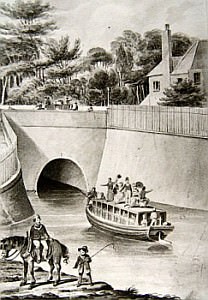
Paddington packet times published in 1810 (above) and drawing of a packet boat (right) at Maida Hill in 1816.
Clearly the Paddington Packet boats had a hopeless task in fighting the competition. Its only advantage over road was a superior level of comfort, including tea and coffee, and a far smoother journey. The major disadvantage of the packet service was its time of over three hours from Cowley to Paddington was exceedingly slow. On top of that was the time expended by its passengers having to make their way from Uxbridge to Cowley in order to join the service. Adjacent road services were direct and offered much more flexibility and faster travel times. Even before the canal had opened the Uxbridge to London Road was known as being one of the busiest in the country. To give an indication of the competition the Paddginton Packet was up against, the fastest road coach services travelled between Oxford and London in about three hours and twenty minutes, against the packet’s three hours from Cowley to Paddington. By the time the Paddington Packet ended, there were at least 52 road coach services between London and Uxbridge. Forty of these services headed for Oxford and the western parts of the country.

The Paddington Packet basin entrance at Cowley on the main Grand Union Canal route, where the express boats started out for London.
